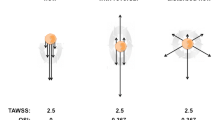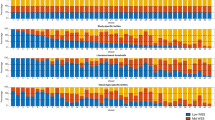Abstract
It is generally accepted that low and oscillatory wall shear stress favors the initiation and development of atherosclerosis. However, a quantitative analysis of the association between shear stress metrics at baseline and lesion prevalence at a later stage is challenging to perform in vivo on a within-subject basis. In this study, we assessed carotid hemodynamics and derived hemodynamic wall parameters from subject-specific fluid–structure interaction simulations in the left and right carotid arteries of 4 ApoE−/− mice prior to disease development. We then applied a point-by-point quantitative association (surrogate sample data analysis) between various established and more recent shear related parameters and the extent of macrophage infiltration at a later stage. We conclude that, for the atherosclerotic murine carotid bifurcation, (i) there is an association between hemodynamics and macrophage infiltration; (ii) this correlation is most apparent when assessed at the level of the entire carotid bifurcation; (iii) the strongest spatial correlation between hemodynamics and atherosclerosis development was found for the time averaged wall shear stress (negative correlation) and the relative residence time (positive correlation); (iv) aggregating the data leads to an overestimation of the correlation.



Similar content being viewed by others
References
Antiga, L., and D. A. A. Steinman. Robust and objective decomposition and mapping of bifurcating vessels. IEEE Trans. Med. Imaging 23:704–713, 2004.
De Wilde D., B. Trachet, N. Debusschere, F. Iannaccone, A. Swillens, J. Degroote, J. Vierendeels, G.R.Y. De Meyer, P. Segers. Assessment of shear stress related parameters in the carotid bifurcation using mouse-specific FSI simulations. J Biomech. Accepted for publication,2015.
De Wilde, D., B. Trachet, C. Van der Donckt, B. Vandeghinste, B. Descamps, C. Vanhove, G. R. Y. De Meyer, and P. Segers. Vulnerable plaque detection and quantification with gold particle-enhanced computed tomography in atherosclerotic mouse models. Mol. Imaging. 14:9–19, 2015.
Gelfand, B. D., F. H. Epstein, and B. R. Blackman. Spatial and spectral heterogeneity of time-varying shear stress profiles in the carotid bifurcation by phase-contrast MRI. J. Magn. Reson. Imaging 24:1386–1392, 2006.
Gijsen, F. J. H. H., J. J. Wentzel, A. Thury, B. Lamers, J. C. H. H. Schuurbiers, P. W. Serruys, and A. F. van der Steen. A new imaging technique to study 3-D plaque and shear stress distribution in human coronary artery bifurcations in vivo. J. Biomech. 40:2349–2357, 2007.
Glagov, S., C. Zarins, D. P. Giddens, and D. N. Ku. Hemodynamics and atherosclerosis. Insights and perspectives gained from studies of human arteries. Arch. Pathol. Lab. Med. 112:1018–1031, 1988.
He, X. Pulsatile flow in the human left coronary artery bifurcation: average conditions. J. Biomech. Eng. 118:74–82, 1996.
Himburg, H. A., S. E. Dowd, and M. H. Friedman. Frequency-dependent response of the vascular endothelium to pulsatile shear stress. Am. J. Physiol. Heart Circ. Physiol. 293:H645–H653, 2007.
Himburg, H. A., and M. H. Friedman. Correspondence of low mean shear and high harmonic content in the porcine iliac arteries. J. Biomech. Eng. 128:852–856, 2006.
Himburg, H. A., D. M. Grzybowski, A. L. Hazel, J. A. LaMack, X.-M. Li, and M. H. Friedman. Spatial comparison between wall shear stress measures and porcine arterial endothelial permeability. Am. J. Physiol. Heart Circ. Physiol. 286:H1916–H1922, 2004.
Insull, W. The pathology of atherosclerosis: plaque development and plaque responses to medical treatment. Am. J. Med. 122:S3–S14, 2009.
Jawien, J., R. Nastalek, R. Korbut, J. Jawień, P. Nastałek, and R. Korbut. Mouse models of experimental atherosclerosis. J. Physiol. Pharmacol. 55:503–517, 2004.
Joshi, A. K., R. L. Leask, J. G. Myers, M. Ojha, J. Butany, and C. R. Ethier. Intimal thickness is not associated with wall shear stress patterns in the human right coronary artery. Arterioscler. Thromb. Vasc. Biol. 24:2408–2413, 2004.
Ku, D. N., D. P. Giddens, C. K. Zarins, and S. Glagov. Pulsatile flow and atherosclerosis in the human carotid bifurcation. Positive correlation between plaque location and low oscillating shear stress. Arteriosclerosis. 5:293–302, 1985.
Lee, S.-W., L. Antiga, and D. A. Steinman. Correlations among indicators of disturbed flow at the normal carotid bifurcation. J. Biomech. Eng. 131:061013, 2009.
Libby, P. Inflammation in atherosclerosis. Nature 420:868–874, 2002.
Malek, A. M., S. L. Alper, and S. Izumo. Hemodynamic shear stress and its role in atherosclerosis. JAMA 282:2035–2042, 1999.
Peiffer, V., A. A. Bharath, S. J. Sherwin, and P. D. Weinberg. A novel method for quantifying spatial correlations between patterns of atherosclerosis and hemodynamic factors. J. Biomech. Eng. 135:021023, 2013.
Peiffer, V., S. J. Sherwin, and P. D. Weinberg. Does low and oscillatory wall shear stress correlate spatially with early atherosclerosis? A systematic review. Cardiovasc. Res. 99:242–250, 2013.
Peiffer, V., S. J. Sherwin, and P. D. Weinberg. Computation in the rabbit aorta of a new metric—the transverse wall shear stress—to quantify the multidirectional character of disturbed blood flow. J. Biomech. 46:2651–2658, 2013.
Pendse, A. A., J. M. Arbones-Mainar, L. A. Johnson, M. K. Altenburg, and N. Maeda. Apolipoprotein E knock-out and knock-in mice: atherosclerosis, metabolic syndrome, and beyond. J. Lipid Res. 50(Suppl):S178–S182, 2009.
Rowland, E. M., Y. Mohamied, K. Yean Choi, E. L. Bailey, and P. D. Weinberg. Comparison of statistical methods for assessing spatial correlations between maps of different arterial properties. J. Biomech. Eng. 137:101003, 2015.
Van der Donckt, C., J. L. Van Herck, D. M. Schrijvers, G. Vanhoutte, M. Verhoye, I. Blockx, et al. Elastin fragmentation in atherosclerotic mice leads to intraplaque neovascularization, plaque rupture, myocardial infarction, stroke, and sudden death. Eur. Heart J. 36:1049–1058, 2014.
Whitman, S. C. A practical approach to using mice in atherosclerosis research. Clin. Biochem. Rev. 25:81–93, 2004.
Acknowledgments
David De Wilde is supported by a research grant of the Flemish government agency for Innovation by Science and Technology (IWT). Bram Trachet receives support from a BOF grand of Ghent University. We thank Francisco Londono, Mathias Peirlinck, Christian Vanhove, Benedicte Descamps, Scharon Bruneel, Bert Vandeghinste, Nic Debusschere, Abigail Swillens, Joris Degroote, Jan Vierendeels, Francesco Iannaccone, Liesbeth Taelman, Joris Bols and Carole Van der Donckt for their assistance.
Conflict of interest
No conflict of interest.
Author information
Authors and Affiliations
Corresponding author
Additional information
Associate Editor Andreas Anayiotos oversaw the review of this article.
Rights and permissions
About this article
Cite this article
De Wilde, D., Trachet, B., De Meyer, G.R.Y. et al. Shear Stress Metrics and Their Relation to Atherosclerosis: An In Vivo Follow-up Study in Atherosclerotic Mice. Ann Biomed Eng 44, 2327–2338 (2016). https://doi.org/10.1007/s10439-015-1540-z
Received:
Accepted:
Published:
Issue Date:
DOI: https://doi.org/10.1007/s10439-015-1540-z




